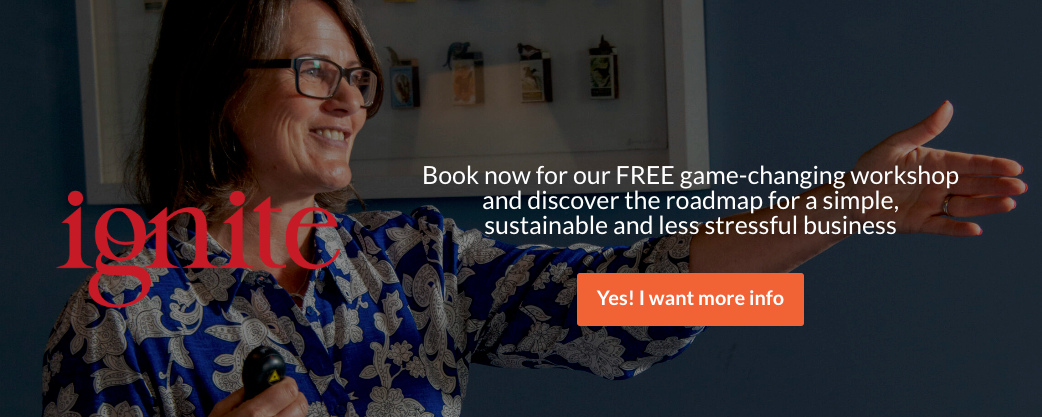As a woman of a certain age, I’ve grown wise to the fact that two things are most precious to us: time and energy
But we can often spend our whole lives giving them away without a moment’s thought.
When we feel we have lots of time and energy, we can take them for granted.
But when we don’t have much of either, we grind along, working to other people’s schedules and demands. They exist as a finite resource for everyone, no matter where you live, and yet we can’t make more of either of them when we run out.
They are the most valuable resources we have in our lives and businesses, and yet without some fundamental boundaries in place; we will under-value them and give them both away to anyone who demands them of us, without recognising the need to use them first on ourselves and what’s important to us.
In my 20s and 30s, I often felt I had boundless amounts of both. If I felt tired, I would grab another cup of coffee. If I were hungry and didn’t have the energy to cook a meal, I would throw a ready meal in the microwave or eat a sandwich on the run.
We could do that then, couldn’t we? Without much thought to the consequences or long-term impact.
But as I woke up to my 40s, kicking off the decade with a young family (2 kids just 22 months apart), reeling from losing my dad to cancer and a business to run, my time and energy resources were suddenly depleted.
That coffee fix or sandwich on the run didn’t quite do the job as it had in my 20s, and I spent most of that decade crawling my way through quite extreme peri-menopausal symptoms, over-worked adrenals and wearing my Superwoman cape to get by every day.
But what has all this got to do with business?
There’s a magic word that I want to share with you that has become one of the most essential strategies to my business growth and comes up repeatedly in our coaching conversations with our clients.
Boundaries
Without boundaries to protect and fuel your time and energy resources, you will often end up working like a ‘busy fool’, as one of my clients called herself before we began working together. You may be making money, but the amount of hours you put in and the money you pay yourself at the end of each month doesn’t feel worth it.
In this article, I’d like to share the top 4 work boundaries I’d recommend you have in place to increase your profitability and avoid burnout.
1. Hours Worked
What hours are you prepared to work?
Very few clients I have worked with have ever stopped to think about how their ideal week could look; they have allowed their weekly routine to be shaped by what their business gives them.
When you started your business, your work diary probably looked very empty. It’s not until you begin marketing, start working with clients and become able to attend various events or conferences that you find your diary getting booked up. Meetings are being scheduled to suit other people. You don’t consider the preparation or rest time you need between appointments. Your once-open diary is now pulling you apart; you’re wearing your busy badge of honour, and you don’t have the time to focus on projects that could grow your business.
The irony of time management is that you can’t manage time; you can only manage yourself.
To stop this, I’d recommend you take a breath and work out your ideal week. If a week feels too routine for you and you imagine different things happening at other times of your working month, change the time frame to an ideal month.
Here is a list of questions to help you define your ideal week.
- My ideal working week starts on …
- What would I do on my first working day to set the right tone for my week?
- How would I spend the other days? (For example, are certain mornings or afternoons important to keep clear for certain activities?)
- My favourite day of the week is … and this is the reason why …
- The days and hours I want to work with my clients are …
- I am most in flow during this time …
- What I love to be spending most of my time doing is …
- Who I want to be spending more of my time with is …
- When I am not working, I want to be … (This question is crucial for those of you who don’t have other commitments, such as family members to look after, to pre-determine your working hours. It can be far harder to switch off from work when you only have yourself to be committed to, so decide what you want to do when you are not working.)
- How I want to feel at the end of my ideal week is …
- What do I want to do or achieve daily?
- What do I want to do or achieve weekly?
- What do I want to do or achieve monthly?
- What are you not prepared to sacrifice? (Are your Fridays sacred? Do you have to pick up children every day at 3.30 pm? Are you happy to work during the weekends but you have to have two days off during the week? Decide what time you aren’t prepared to give away so you can set those boundaries in place now and avoid frustration or resentment at a later date.)
Once you have answered these questions, could you decide what changes you can make to your scheduling and working hours? Do you need to block out certain mornings or afternoons for routine activities, such as content creation or team meetings?
If you cannot make any immediate changes, at what point can you introduce this new schedule? Can you add this to your diary right now?
You control who and what takes your attention during your working week. Some may not feel this is the case, especially if you are fully booked with clients for the next weeks or months. But when you decide what’s important to you in spending your time, you set the necessary boundaries to create the space to grow. You will realise that the right clients will want to work with you when you are available rather than you being dictated by their schedules.
2. Capacity Available
What is your capacity and availability for taking on new clients?
I often hear business owners asking for more clients, but they haven’t stopped to consider how many clients would give them a ‘full’ business. Think of your business like a hotel booking sheet. A hotel will have a finite number of rooms to sell for every day of the week. No matter what you sell, you will find an optimum level of clients, products, or programs you can sell while maintaining the service level you want to give.
If you choose to maximise your sales and compete on price (AKA always sell at lower prices because you feel it’s easier for you to sell), you are going to find this a challenging marketing strategy; competition is going to be tight, and you have to ensure you have the distribution channels or delivery systems in place to keep up with the demand.
For most of you reading this, you will have better success in optimising your sales and deciding how many clients or customers you can serve in any one week or month. By doing your sales numbers this way, you can work your charge rates back from here once you’ve decided how much you want to earn and thus set your boundaries on how many clients you can effectively onboard each week, month or quarter. This simple exercise can radically change your profitability overnight, and if you need help working this through, get in touch.
Please email me at [email protected], and I’ll happily arrange for one of our coaches to talk you through the process and help assess your profitability options.
3. Communication Channels
Technology is a double-edged sword; it’s made communicating and corresponding with clients and prospects more accessible than ever … but that’s also meant that you are in danger of managing multiple platforms, never being able to follow a message trail, and constantly switching on.
The first rule of communication is that you DON’T have to be everywhere or have every messaging app switched on at all times.
Yes, your clients may have their preferences, but if you allow them to communicate with you on their messaging channel of choice, you will let your precious time and energy run out each day. You decide which communication channel(s) you want to use and set your working hours.
For example, you may want to only use email for all communications on the projects you are working on, and you promise to respond within one working day or the same day if you get their email before 2 pm. And for all quick messages or check-ins before meetings, you keep your WhatsApp between 9 am and 5 pm, Monday through Thursday.
Over the years, I have had many clients complain of having to answer WhatsApp messages on Sunday mornings or late at night. But the truth is that they have allowed that relationship to happen because they didn’t have clear communication channel boundaries set up at the start of their relationship.
If these boundaries slip as the relationship goes on (as often is the case if a client forgets or gets comfortable with working with you and treats you as they would any other team member), you can remind them of the original agreement and reset the boundary again.
For those of you who run a business that serves hundreds of customers online, the same principle applies to customer support and help desks. Could you clarify what support your business offers and when so your customers know what is expected? Lousy customer support happens when there are no clear communication boundaries set up, and the customer will ALWAYS have higher expectations of response than you can give them. So, avoid this from happening by setting clear expectations upfront.
4. Holidays & Time Off
Last but not least is the need for holiday boundaries. I see only a few self-employed business owners rarely plan their holiday times.
If employed, you would automatically get 20+ days of holiday a year. And yet, when most people want to work for themselves because of the freedom of choice, they rarely take holidays. The irony!
For many, holidays and time off are forced upon you, either by kids’ school holidays or you end up booking a week off just as you reach breaking point and the holiday becomes a necessity before you keel over in exhaustion.
Holidays and days off need to be planned.
Without this, you will keep working and working and working. Set the boundaries now, and look ahead over the next 12+ months and decide which days you want to set clear for holidays.
You don’t have to book anywhere, nor do you need to decide what you want to do with that time off. But without blocking these days out in your diary, you will automatically fill up the space with more work and more work. I have to do this myself every 3 or 4 months, on top of our family holiday time. If I didn’t block out chunks of 2 or 3 days around the flow of our business, I would keep on trucking, which I know is not suitable for me over a long period.
What Now?
These four boundaries may be just the foundation for you to work on more, depending on your business model and how you work with your clients. But if you have found yourself working like a ‘busy fool’, starting with these will hugely help shift your patterns of work and help reclaim your time, energy, and precious resources.
Now that you’ve read through this, I recommend you schedule the time to work through each. You will need time and energy to do this, a clear space to think and reflect on what’s important to you. Some of you will think you won’t have the time, but this will be because you need to have the proper boundaries for yourself and your business. You need to take this critical time out to avoid keeping those wheels spinning.
If you are super busy, start with a small slot of just 20 minutes – just the right amount of time to sit down with a cuppa – and work through the first one, Hours Worked. This is the most doable one to put into place, especially if you start to change your schedule two months hence. This may not make an immediate difference, but if you do, you will thank yourself for your forward thinking in just two months!
If you would like to know more and want help with how you shape the way you run your business, then I invite you to join me on my next live Ignite Workshop. It’s a great place to learn more about how business can work FOR you rather than have a business that works you into the ground.
Check out the next dates and book your place.
And if you know someone else who needs to read this article, please share it with them. You could be saving their health and sanity!









